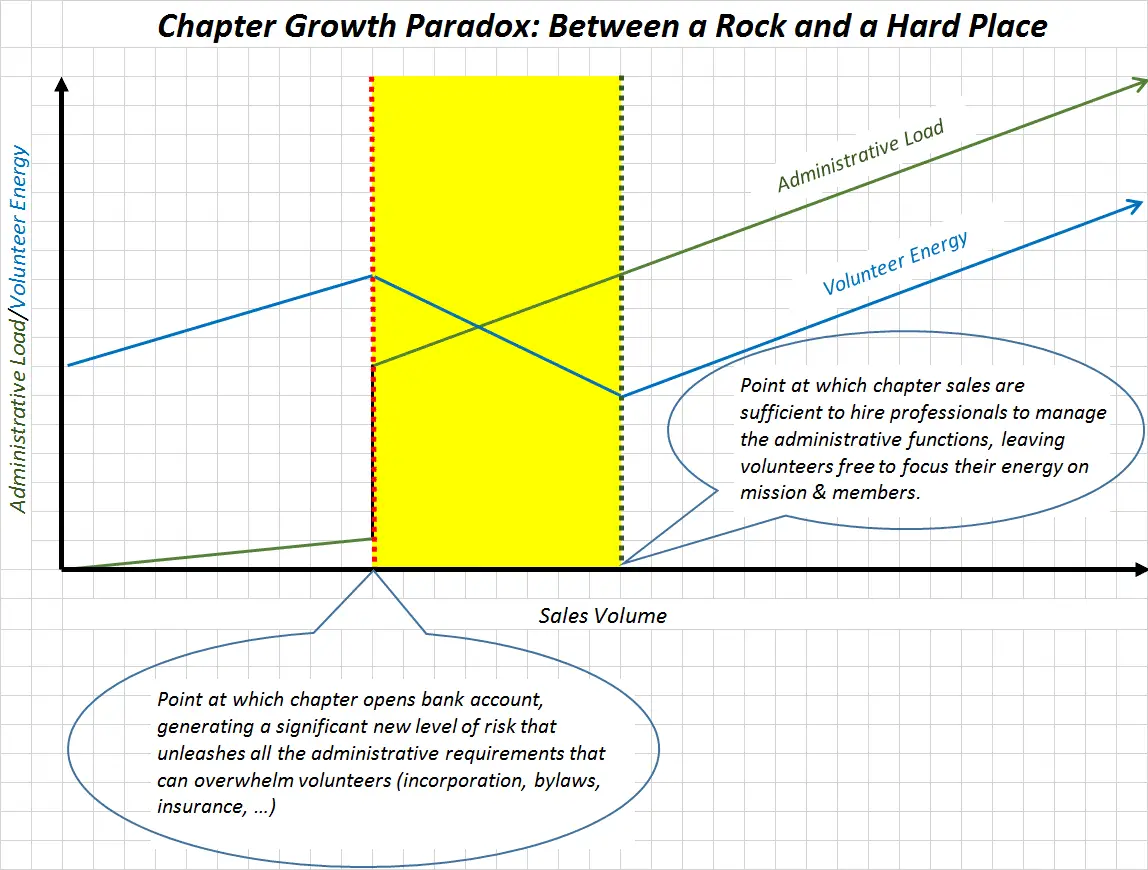There is a paradox of growth which occurs when a chapter reaches the size where incorporation is required to create an entity which can
open a bank account.
Volunteers in entities to the left of the “Rock and a Hard Place” spend the bulk of their energy and effort on activities which serve the mission and the member (i.e. stuff about which they’re both passionate and knowledgeable). Once the entity moves to the “Rock and a Hard Place”, its sales volume demands a bank account and the concomitant incorporation, legal filings, insurance, boards, board meetings, reports, etc. Now rather than focusing on the mission and the member, the volunteers begin spending increasing amounts of time dealing with organizational issues (incorporation, by-laws, insurance, etc. – i.e. stuff about which they know little and could care less). The paradox of this place is that the entity has enough cash flow to require financial management but lacks enough money to pay for professional administrative support. At a higher sales volume, the entity will be generating funds sufficient to hire professional staff freeing the volunteers up to focus their limited time
and energy on “stuff about which they’re both passionate and knowledgeable.”
Given that most associations have limited human and financial resources, assuring consistency of chapter quality and output and minimizing the time chapters spend in the “Rock and a Hard Place” calls for a multi-faceted system characterized by the following attributes:
- Flexibility – One size does not fit all. Depending on the local situation (culture, politics, language, economics, etc.) and interest/energy of the current volunteer leadership, each chapter may focus on different issues or activities over time. For this reason the human and financial resources each needs to operate at any given moment will vary. On the other hand, the system should support and demand uniformity of quality, alignment and risk management.
- Reasonable Expectations Focused on Mission and Member
Metrics – The environmental heterogeneity noted above suggests that any performance/quality assessment target mission and member metrics (satisfaction) rather than organizational metrics (legal, financial, operational, etc.). Philosophically this means setting a meaningful mission-related goal and leaving as much of the “how” up to the chapters as possible. Just because a chapter hosts an event or multiple events doesn’t necessarily mean it’s moving the mission or serving the member. In fact, events may be the wrong activity altogether depending on the local conditions! See Chapter Performance
Dashboard: Right Side Up - Risk Mitigation with a Light Touch – Any association with chapters/affiliates assumes some level of financial, legal and brand risk. For that reason the charter that governs the relationship needs to specify some level of compliance around organizational metrics (e.g. compliance with local regulatory requirements sufficient to avoid legal risk to the chapter/affiliate and/or primary/headquarters association). The bottom line question we need to address is “What is the likelihood an [association] chapter will do something in the course of its activities that puts the chapter itself and/or [association] at financial, legal or brand risk?” For most associations, this will usually be fairly low for financial and legal, somewhat higher for brand (the promise and the presentation).
- Load Balance – With, on average, limited paid staff dedicated to chapter support, most associations cannot possibly provide extensive and/or frequent one-on-one support to its chapters. For this reason, the system should deliver volunteer support through a number of channels and platforms that make resources available at the moment of need so volunteers have alternative sources for real-time help (see below). In a related area, the complexity of the support system will correlate directly with the variety of software systems and procedures chapters use to implement their programs. The more chapters can be convinced to use that same software and procedures, the easier it will be to deliver training and support – i.e. if everyone, for
example, uses the same email program, the experienced user pool will be much larger and it will be easier for new users to find answers to questions among their peers. - Maximize Many-to-Many – Often, peers represent the most effective resource for chapter leaders when they are taking their first steps in a new (for them) activity. Identifying and activating individuals willing to serve as mentors will go a long way toward creating a many-to-many support system and reducing the support load for staff.
- Optimize Technology – Use technology at both headquarters and local levels wherever possible to maximize connections and minimize the administrative burden. See Tech Tools for
Chapters. This includes fleshing out the volunteer portal, energizing the leader listserv and working toward uniform software and data management options. - Partners – Look to any and all organizations with a shared interest to leverage their expertise and/or resources. “It’s amazing what we can accomplish when we don’t care who gets the credit.” These partners can include for profit entities, universities, local chapters of related associations, larger corporations in the field/industry, etc.
- Make the most of opportunity – Desert in Bloom – While they may appear lifeless and desolate, deserts harbor an incredible capacity to rise to the occasion when opportunity (i.e. rain) flows. The activity of any association’s chapters/affiliates will likely wax and wane over time depending on the presence and energy of volunteers in the area. The system needs to be ready to nourish new leaders when they pop up.
Bottom line, successful chapter systems are opportunistic and keep formal structures as flexible, minimal and nimble as possible, closely adhering to the principle that form should follow function.
